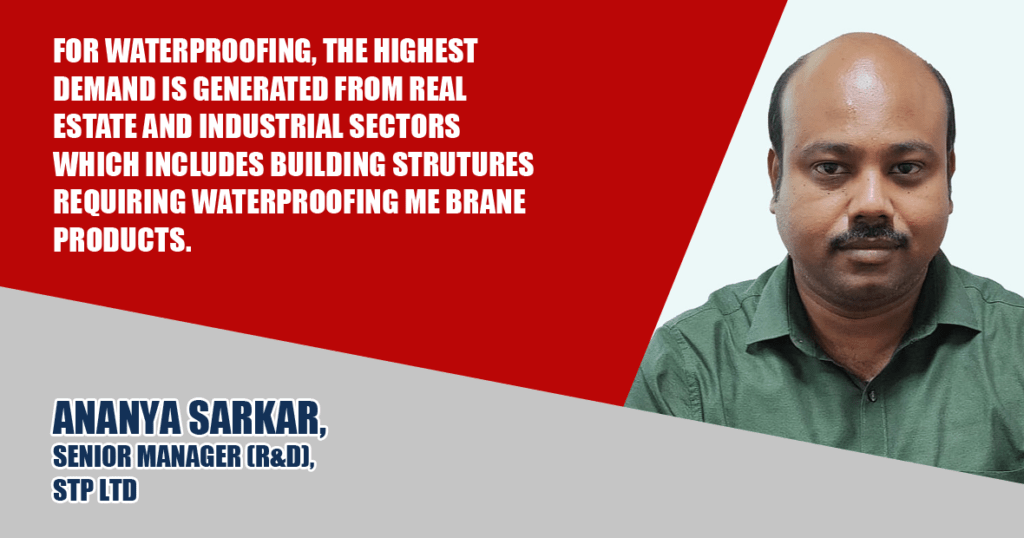For waterproofing, the highest demand is generated from real estate and industrial sectors which includes building structures “ requiring waterproofing membrane products, says Ananya Sarkar, Senior Manager (R&D), STP Ltd.
How is the waterproofing segment evolving in the country? What is the demand trend from different construction segments?
In India, a major shift from traditional waterproofing techniques to modern waterproofing techniques has been observed. Also, there is a growing demand for high-end and better-quality products for various real estate and infrastructure projects. In the last five years, construction chemical market has observed a CAGR of ~15-20 percent due to rising construction activities whereas waterproofing market has grown with double-digit CAGR in Indian market. For waterproofing, the highest demand is generated from real estate and industrial sectors which includes building structures requiring waterproofing membrane products. Hospitality sector has majorly created demand for high-end premium waterproofing products. Also, there is an increasing demand for waterproofing solutions in mining applications. Waterproofing solutions are suitable for mining applications due to their strong durability in exhaustive climates. The key applications of waterproofing solutions in mining industry are to prevent mine explosives and fuse, damaging from exposure to elements such as water and moisture. Waterproofing solutions are important for electrical substations in underground mines as they keep electrical equipment dry and free of corrosion. In the current market scenario, preformed membrane and liquid membranes have ~40-50 percent market share in terms of manufacturer’s revenue.
What are the latest waterproofing solutions offered in concrete?
Grout and epoxy injection: If cracks are forming in the concrete, water penetration can be prevented with epoxy and PU injection grout method. This is done by injecting the chemicals into the cracks, or by drilling holes into the surface. The injected chemical reacts with any remaining water to form a gel or foam that results in creating a water-resistant barrier in place of the former crack.
Polyurethane liquid membranes: Polyurethane is a chemical membrane primarily used to waterproof roofs and exposed areas which is a very flexible system to apply.
Polyurea coating: Polyurea is one of the most resilient and flexible protective coatings. Polyurea is known for being water resistant, abrasion resistant, and very strong.
Crystallisation waterproofing: Crystallisation waterproofing is chemically structured to withstand the effects of key elements that cause corrosion including CO2, NO2, and CO, as well as water damage. The crystalline substance fills gaps in the cement composition to keep water out. The chemicals are capable of setting deep within the concrete to establish long-lasting protection.
Permeability-reducing admixtures (PRAs): These come in several varieties and share similar principles as crystallisation waterproofing. The chemicals used are favoured for their proactive properties that lower concrete permeability and lower chloride-ion effects by strengthening sealings in the concrete.
How is waterproofing gaining prominence in plastering application?
Integral waterproofing additives are used more as a waterproofing solution for plastering application. The aim of integral waterproofing is to densify the plaster to prevent water ingress. Integral waterproofing additives generally function on the basis of one or a combination of the three mechanisms: Reduction of capillarity by w/c ratio reduction; Hydrophobising capillaries; and Physical or chemical pore blocking. Modern plaster additives are available in both powder or liquid form and can be used for site production or for large scale industrial production of dry-mix plaster.
Modern plaster additives improve the following properties in any wall/ceiling plaster: water reduction, waterproofing, ability to be used even with crushed sand, excellent bonding even to concrete blocks, thixotropy, smooth finish, minimal to zero wastage, lesser rebound, improved spray-ability, and minimal labour requirement for finishing.
What are the waterproofing solutions and products used in underground structures?
Underground and foundation structures are vulnerable constructions when it comes to damp and water leakage. Usually there is no sealing membrane to prevent damp and water from penetrating the concrete. In which case it is necessary to waterproof the concrete to prevent damaged caused by damp. The following products are mostly used as waterproofing material for underground structures:
- Pre-form membrane: APP modified bitumen membrane, HDPE membrane, PVC membrane
- Epoxy lining systems, especially coal tar-based epoxy lining
- Sprayable polyurethane and polyurea systems
- Polymer modified cementitious waterproofing systems integral waterproofing additives
- Swelling rubber water stops
- Injection water stops by injection of polyurethane, acrylate or microfine cement.
Cookie Consent
We use cookies to personalize your experience. By continuing to visit this website you agree to our Terms & Conditions, Privacy Policy and Cookie Policy.

















